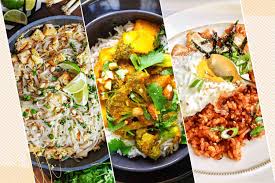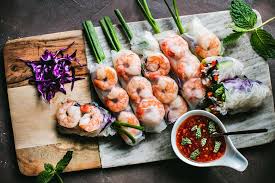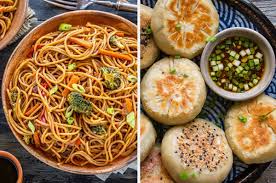Asian cuisine offers a vibrant array of flavors, textures, and ingredients that lend themselves beautifully to vegetarian and vegan cooking. With an emphasis on fresh produce, aromatic herbs, and savory spices, Asian recipes can be incredibly satisfying and healthful while accommodating plant-based diets. As we move into 2024, these vegetarian and vegan Asian recipes are set to take the spotlight, combining traditional elements with contemporary twists to create delicious and innovative dishes. This guide explores some of the best vegetarian and vegan Asian recipes for 2024, offering a mix of classic favorites and new inspirations.
1. Introduction to Asian Vegetarian and Vegan Cuisine

The Essence of Asian Cuisine
Asian cuisine is renowned for its diversity, encompassing a wide range of regional styles and ingredients. Whether it’s the bold flavors of Thai food, the delicate balance of Japanese dishes, or the hearty comfort of Chinese cooking, Asian cuisine provides ample opportunities for creating plant-based meals. Key ingredients often used in vegetarian and vegan Asian recipes include:
- Tofu and Tempeh: Excellent sources of protein and versatile in various dishes.
- Rice and Noodles: Staples that can be combined with a variety of vegetables and sauces.
- Fresh Vegetables and Herbs: Ingredients like bok choy, cilantro, and lemongrass add vibrant flavors and textures.
Benefits of Vegetarian and Vegan Diets
Adopting a vegetarian or vegan diet has numerous benefits:
- Health Benefits: Reduced risk of chronic diseases, improved digestion, and better heart health.
- Environmental Impact: Lower carbon footprint and reduced environmental degradation compared to animal-based diets.
- Ethical Considerations: Aligning with principles of animal welfare and humane treatment.
2. Top Vegetarian and Vegan Asian Recipes for 2024
1. Thai Green Curry with Tofu
Thai green curry is a rich, aromatic dish that can easily be adapted for a vegetarian or vegan diet. This recipe features tofu as a protein source and a variety of vegetables for added nutrition.
Ingredients:
- 1 tablespoon vegetable oil
- 2 tablespoons green curry paste
- 1 can (400 ml) coconut milk
- 1 cup vegetable broth
- 200g tofu, cubed
- 1 cup bell peppers, sliced
- 1 cup zucchini, sliced
- 1 cup baby corn, chopped
- 2 tablespoons soy sauce
- 1 tablespoon brown sugar
- Fresh basil leaves for garnish
Instructions:
- Heat the vegetable oil in a large pan over medium heat. Add the green curry paste and cook for 1-2 minutes until fragrant.
- Pour in the coconut milk and vegetable broth, stirring to combine.
- Add the tofu and vegetables to the pan. Simmer for 10-15 minutes until vegetables are tender.
- Stir in the soy sauce and brown sugar. Adjust seasoning to taste.
- Garnish with fresh basil leaves before serving. Serve hot with jasmine rice.
2. Korean Bibimbap
Bibimbap is a Korean mixed rice dish that can be easily made vegan by using plant-based ingredients and omitting the egg.
Ingredients:
- 2 cups cooked jasmine rice
- 1 cup spinach, blanched
- 1 cup carrots, julienned
- 1 cup mushrooms, sliced
- 1 cup bean sprouts
- 1 cucumber, julienned
- 2 tablespoons sesame oil
- 2 tablespoons soy sauce
- 1 tablespoon gochujang (Korean chili paste)
- 1 teaspoon sesame seeds
Instructions:
- Heat sesame oil in a pan over medium heat. Sauté carrots, mushrooms, and bean sprouts until tender. Season with soy sauce.
- Assemble the bibimbap by placing a serving of rice in each bowl. Arrange the cooked vegetables and cucumber on top.
- Drizzle with gochujang and sprinkle with sesame seeds.
- Serve with additional soy sauce or a sprinkle of sesame oil if desired.
3. Japanese Miso Soup with Tofu
Miso soup is a staple in Japanese cuisine that’s both comforting and nutritious. This vegan version uses tofu and seaweed for added protein and umami flavor.
Ingredients:
- 4 cups vegetable broth
- 1/4 cup white miso paste
- 200g tofu, cubed
- 1 cup wakame seaweed, soaked and chopped
- 2 green onions, sliced
- 1 tablespoon soy sauce
Instructions:
- Heat vegetable broth in a pot over medium heat until simmering.
- Dissolve the miso paste in a small amount of warm broth and then stir it back into the pot.
- Add tofu and seaweed. Simmer for 5 minutes.
- Stir in soy sauce and green onions. Adjust seasoning to taste.
- Serve hot as a starter or light meal.
4. Vietnamese Summer Rolls

These fresh spring rolls are filled with vegetables and herbs, and can be paired with a tangy dipping sauce. They make for a refreshing and healthy appetizer or light meal.
Ingredients:
- 8 rice paper wrappers
- 1 cup rice noodles, cooked
- 1 cup shredded lettuce
- 1 cup julienned carrots
- 1 cup cucumber, julienned
- 1/2 cup fresh mint leaves
- 1/2 cup fresh basil leaves
- 1/2 cup cilantro leaves
For the dipping sauce:
- 3 tablespoons hoisin sauce
- 2 tablespoons soy sauce
- 1 tablespoon lime juice
- 1 teaspoon sesame oil
Instructions:
- Soak rice paper wrappers in warm water for 10-15 seconds until pliable. Lay them flat on a clean surface.
- Place a small amount of rice noodles, lettuce, carrots, cucumber, and herbs in the center of each wrapper.
- Fold the sides over the filling and roll tightly to form spring rolls.
- Mix dipping sauce ingredients together in a small bowl.
- Serve the summer rolls with dipping sauce on the side.
5. Chinese Eggplant in Garlic Sauce
This flavorful dish features eggplant cooked in a savory garlic sauce. It’s a great way to enjoy this versatile vegetable in a satisfying vegan recipe.
Ingredients:
- 2 tablespoons vegetable oil
- 3 cloves garlic, minced
- 1 tablespoon ginger, minced
- 1/4 cup soy sauce
- 2 tablespoons rice vinegar
- 2 tablespoons hoisin sauce
- 1 tablespoon brown sugar
- 2 medium eggplants, cut into bite-sized pieces
- 1/4 cup water
- 1 tablespoon cornstarch mixed with 2 tablespoons water
Instructions:
- Heat vegetable oil in a large pan over medium heat. Add garlic and ginger, and cook for 1 minute until fragrant.
- Stir in soy sauce, rice vinegar, hoisin sauce, and brown sugar. Cook for another 2 minutes.
- Add eggplant and water, and cover the pan. Cook for 10-15 minutes, stirring occasionally, until eggplant is tender.
- Stir in the cornstarch mixture and cook until the sauce thickens.
- Serve hot with steamed rice.
3. Tips for Cooking Vegetarian and Vegan Asian Dishes

1. Use Fresh Ingredients
For the best flavor and nutritional value, use fresh vegetables, herbs, and spices. Fresh ingredients enhance the taste and texture of your dishes.
2. Experiment with Substitutes
Many Asian recipes can be adapted for vegetarian and vegan diets by substituting ingredients. For example, use tofu or tempeh instead of meat and plant-based sauces instead of those containing animal products.
3. Balance Flavors
Asian cuisine is known for its balance of flavors—sweet, salty, sour, and spicy. Experiment with different ingredients to achieve the perfect balance in your dishes.
4. Prepare in Advance
Many Asian recipes, such as soups and curries, can be prepared in advance and stored in the refrigerator or freezer. This makes meal planning and preparation easier.
4. Conclusion
As we look forward to 2024, vegetarian and vegan Asian recipes offer an exciting array of flavors and options for those seeking plant-based meals. By embracing the rich traditions and innovative approaches of Asian cuisine, you can enjoy delicious and healthful dishes that cater to vegetarian and vegan diets. Whether you’re making Thai green curry, Korean bibimbap, or fresh Vietnamese summer rolls, these recipes highlight the versatility and appeal of plant-based cooking in Asian cuisine. So gather your ingredients, get cooking, and savor the vibrant tastes of Asian vegetarian and vegan recipes.



